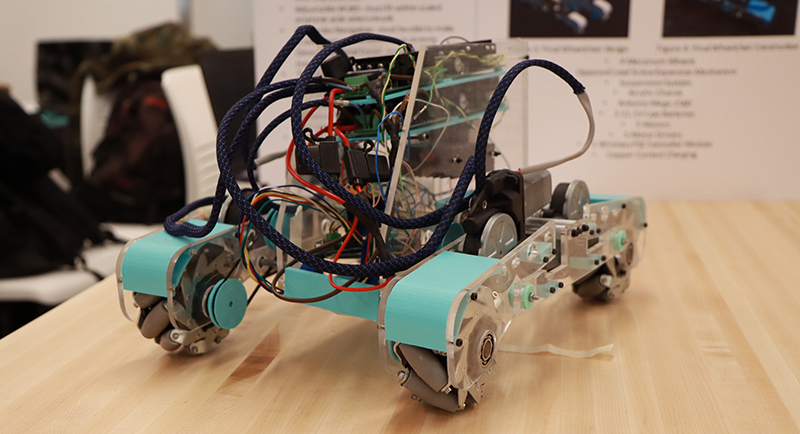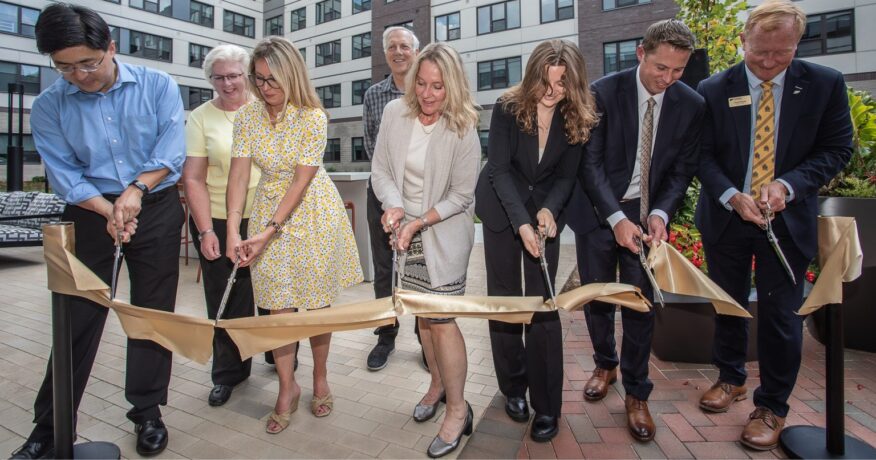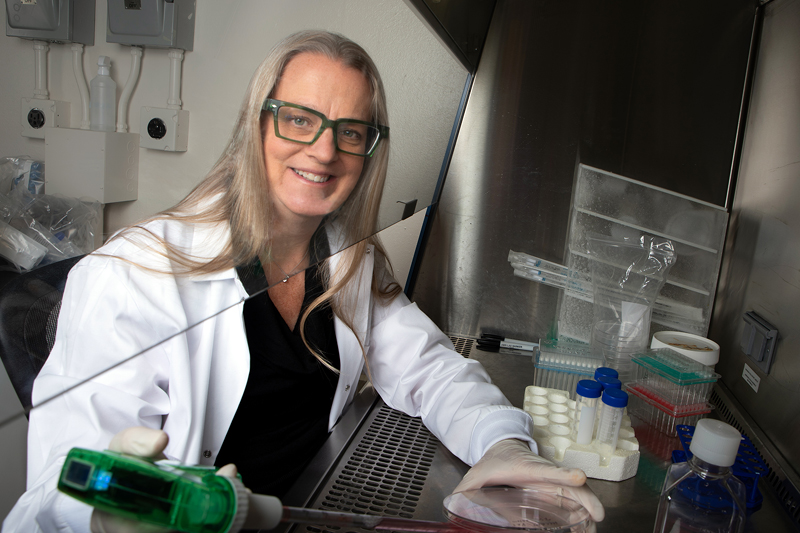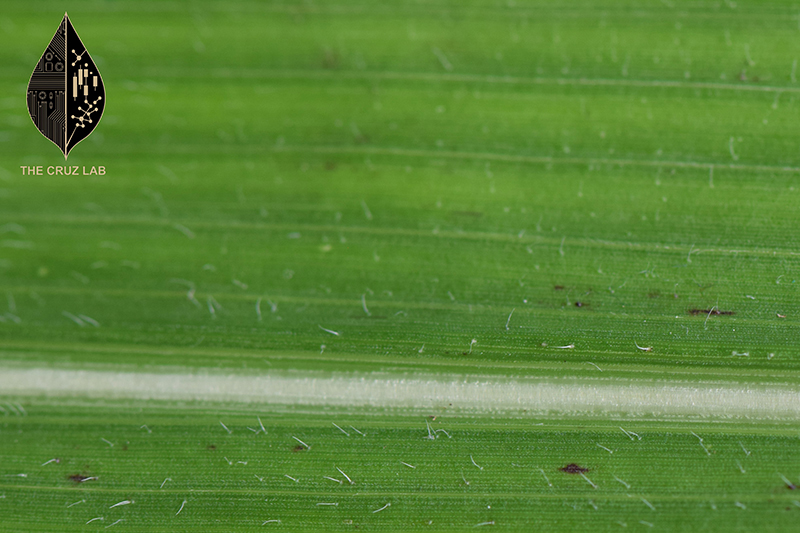Wheelchair prototype safely navigates passengers through airports to aircraft seats
FAA award-winning, patent-pending design travels omnidirectionally and has an adjustable base

A wheelchair prototype designed by teams of recent graduates from the Purdue Polytechnic Institute, College of Engineering and College of Science is being developed to help passengers navigate airports and travel through airplane aisles. (Purdue University photo/Zach Rodimel)
WEST LAFAYETTE, Ind. —
Teams of recent Purdue University graduates have honed a patent-pending, dynamically adjustable wheelchair prototype designed to help users more efficiently and safely navigate airports, board aircraft and move through narrow aisleways to their seats.
A nine-minute video about the work is online.
Peter Ponticello, a recent alumnus of Purdue University’s Polytechnic Institute and a team member who worked to fine-tune the design, said navigating an airport requires addressing various floor surfaces and narrow aircraft aisles.
“It is extremely difficult for a passenger to board an airplane without requiring constant assistance from a dedicated usher throughout the process,” Ponticello said.
The current standard for wheelchair users is to transfer between multiple devices: wheelchairs, airport buggies and aisle chairs when boarding and deplaning a commercial aircraft. This requires airport personnel to lift and move passengers from one device to another, which could lead to physical harm.
Brad Duerstock is a power wheelchair user and professor of practice in the Weldon School of Biomedical Engineering and School of Industrial Engineering; he is unrelated to the wheelchair prototype design project.
“The requirement to transfer to a normal airline seat is fraught with many hazards that have led to personal injury to the wheelchair user and/or the airline attendant,” Duerstock said.
Typical transfers of wheelchair users between their wheelchair and an aisle chair occurs in the jetway.

“It always delays the boarding of passengers who must wait for the wheelchair user to be physically transferred into the aisle chair and then enter into the airplane and then transfer again into airplane seat,” Duerstock said. “This is not only dangerous but very inefficient.”
Ponticello, Connor Edwards, Logan Gardocki and Cole Mulzer are recent Purdue graduates, and Jack Moran is scheduled to graduate this year. They worked on a remote-operated and battery-powered base for the wheelchair that functions as all three traditionally employed devices.
“It travels omnidirectionally and features an improved turn radius compared to currently available wheelchairs,” Ponticello said.
The base also dynamically contracts from 18-by-18-by-22-inch to 18-by-10-by-22 to pass through narrow aisles.
The original design won the 2020 FAA Challenge: Smart Connected Aviation Student Competition. Team members were Austin Barrow, Eric Eagon, Quinn Joyce, Dylan Kerr, James Pannullo and Xingmei Zhu from the School of Aeronautics and Astronautics, and Brendan Kerr from the Department of Computer Science. Eagon and Joyce were co-leaders; Dengfeng Sun, a professor in the School of Aeronautics and Astronautics, served as the team’s academic mentor. Another Polytechnic team of Tyler Affolder, Allana Brown, Brandon Mair, Caleb Phillips, Wade Ridge and Joseph Warren also worked on design. James Condron, assistant professor of practice, advised both Purdue Polytechnic Institute teams.
“After we studied previous versions of the design, we updated the software, redid the electrical setup and redesigned the mechanical features,” Ponticello said.
Along with being safer than traditional methods to transport passengers to planes, Ponticello said the device is cost-efficient for airports.
“This wheelchair allows for those who need to utilize a wheelchair in an airport to do so without the constant assistance of an usher,” Ponticello said. “This greatly reduces the amount that airports spend on ushers who assist those with limited mobility.”
The first team that worked on the design disclosed it to the Purdue Research Foundation Office of Technology Commercialization, which has applied for a patent on the intellectual property. Industry partners interested in further developing the design should contact Matt Halladay, mrhalladay@prf.org, about track code 2020-JOYC-68976.
The Purdue teams have validated the concept of the design by testing it on a variety of flooring surfaces and through spaces that replicate the dimensions of aircraft aisleways. Commercial partners are being sought to advance the design further, including enabling it to transport a passenger from an airport entrance and then take them to a designated gate and exact aisle seat on an aircraft.
About Purdue University
Purdue University is a top public research institution developing practical solutions to today’s toughest challenges. Ranked in each of the last five years as one of the 10 Most Innovative universities in the United States by U.S. News & World Report, Purdue delivers world-changing research and out-of-this-world discovery. Committed to hands-on and online, real-world learning, Purdue offers a transformative education to all. Committed to affordability and accessibility, Purdue has frozen tuition and most fees at 2012-13 levels, enabling more students than ever to graduate debt-free. See how Purdue never stops in the persistent pursuit of the next giant leap at https://stories.purdue.edu.
About Purdue Research Foundation Office of Technology Commercialization
The Purdue Research Foundation Office of Technology Commercialization operates one of the most comprehensive technology-transfer programs among leading research universities in the U.S. Services provided by this office support the economic development initiatives of Purdue University and benefit the university’s academic activities through commercializing, licensing and protecting Purdue intellectual property. In fiscal year 2021, the office reported 159 deals finalized with 236 technologies signed, 394 disclosures received and 187 issued U.S. patents. The office is managed by the Purdue Research Foundation, which received the 2019 Innovation and Economic Prosperity Universities Award for Place from the Association of Public and Land-grant Universities. In 2020 IPWatchdog Institute ranked Purdue third nationally in startup creation and in the top 20 for patents. The Purdue Research Foundation is a private, nonprofit foundation created to advance the mission of Purdue University. Contact otcip@prf.org for more information.
Writer/Media contact: Steve Martin, sgmartin@prf.org
Sources: Peter Ponticello, ppontice@purdue.edu
Matt Halladay, mrhalladay@prf.org



